WINTER WARBLER:
SEED-EATING GOLDFINCH LOOK-ALIKE?
When folks in the Carolina Piedmont mention warblers, it usually conjures visions of a warm spring day with a southerly breeze and dozens of colorful treetop birds moving through on their way to breeding grounds up north. Or, it might remind one of a crisp autumn day when the offspring of those spring migrants start south on their first big flight, wearing drab colors that lead many of them to be called "confusing fall warblers." Seldom, however, does the word "warbler" drum up thoughts of ice and snow--even though a few warbler species can be found around Hilton Pond Center long after their Neotropical relatives are long gone. We were reminded of winter warblers just this week when--accompanied by a bunch of American Goldfinches--a bright greenish-yellow Pine Warbler entered a trap baited with sunflower seeds. We're not sure if the warbler was having an identify crisis--after all, he was similar in color to the goldfinches--or if he had just developed a hankering for oilseed. Nonetheless, there he was, a bird with tapered, insect-eating bill fluttering around in a trap with 12 unrelated avian buddies that had conical bills adapted for seed-cracking.
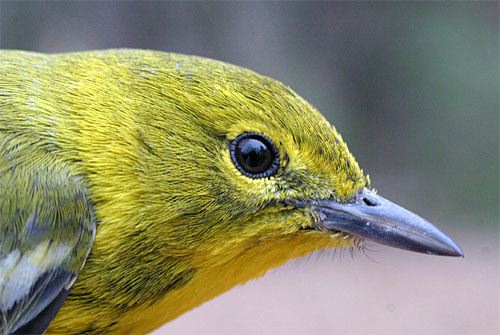
All text & photos © Hilton Pond Center
As I removed this baker's dozen of yellow birds from the trap, it was easy to see why novice birders sometimes have trouble differentiating one species from another. The Pine Warbler, Dendroica pinus, superficially resembled an American Goldfinch in winter plumage (adult male, below left) with its basic yellow color, dark wings, and white wingbars.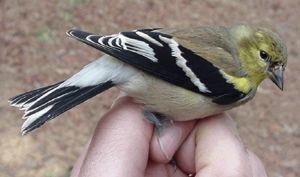 (Note that female goldfinches have browner wings that are nearer in color to those of the Pine Warbler.) (Note that female goldfinches have browner wings that are nearer in color to those of the Pine Warbler.)
A closer look at both species, however, really shows there are as many differences as similarities, starting with the bill shape mentioned previously; the overall body form is also different, with the goldfinch being a much chunkier bird. While both species have two prominent white wingbars--the tips of the lesser and secondary covert feathers--much of the white in a goldfinch wing is actually on the tips and front edges of the primaries (the long flight feathers). Interestingly, in older male goldfinches (above left), the lesser coverts are bright yellow and produce a yellow "shoulder" effect. During winter, the goldfinch's rump and belly are mostly white, while in a Pine Warbler (below) only the belly is whitish.
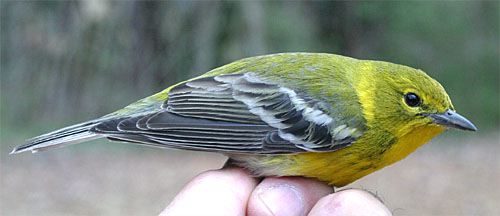
The Pine Warbler and American Goldfinch both have white tail spots, but in the warbler (below) they're on the two outermost tail feathers while ALL are spotted on the goldfinch. We should mention that there's a great deal of plumage variation in both American Goldfinches and Pine Warblers; the warbler we caught this week was particularly bright, but we have captured individuals that were nearly gray. Adult male Pine Warblers have the brightest plumage and young females the dullest, so we're confident the bird illustrated here is a male.
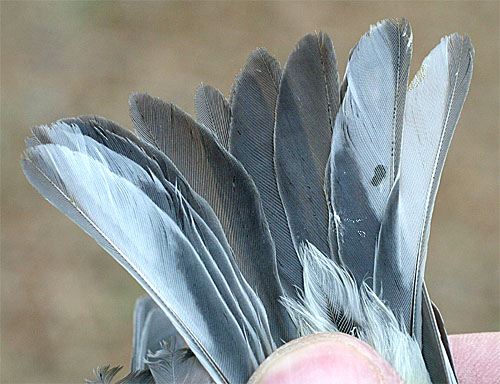
In addition to this week's winter capture, we've caught Pine Warblers during all seasons at Hilton Pond Center; since 1982 we've banded 135 of them--mostly birds that were mist netted in spring and early summer. It's likely the majority of these were resident birds, although some fall and winter captures may have been migrants from the Great Lakes or Appalachian regions that flew no further south than the Carolina Piedmont.
Pine Warblers aren't the only members of the Wood Warbler Family (Parulidae) to be found at Hilton Pond in winter. By far our most common cold-weather species is the Yellow-rumped (Myrtle) Warbler, a bird that breeds across southern Canada and New England and winters primarily in the Southeast and Midwest. On rare occasions we see a Palm Warbler, Orange-crowned Warbler, or Common Yellowthroat after mid-October, but of the 34 warbler species we've banded locally, most are pretty much warm weather junkies that migrate through on their way to Mexico, Central America, or even South America.
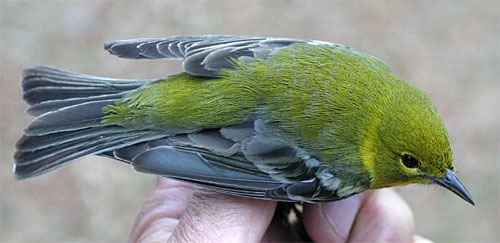
Pine Warblers are aptly named, for they prefer to nest and forage in piney woods, especially in the southeastern U.S. As evidence, consider the following scenario. Back in the 1980s and early 1990s, Pine Warblers were quite common around Hilton Pond. Then, in 1996, a farmer clearcut 60-plus acres of mature Loblolly Pines that adjoined our property and converted the land into pasture. Quite abruptly, our yearly average of banded Pine Warblers dropped from ten to barely one. Since 1995 we've only caught 12, even though in the 1986 banding year alone we handled 22. We have so few mature pines at Hilton Pond Center it's unlikely we have a very large breeding population of Pine Warblers, so we doubt we'll ever see numbers like we had prior to the pinewoods logging operation.
The Pine Warbler we banded this week wasn't the first we've caught in a seed trap. However, since they are primarily insectivores that slowly glean insects from pine needles, cones, and bark, it might seem surprising that Pine Warblers would go after sunflowers with a bunch of goldfinches. With big, succulent insects and caterpillars in short supply during cold months, the very fact that Pine Warblers are resourceful enough to use other foods is what enables them to be among the few wood warblers that don't migrate to the tropics. 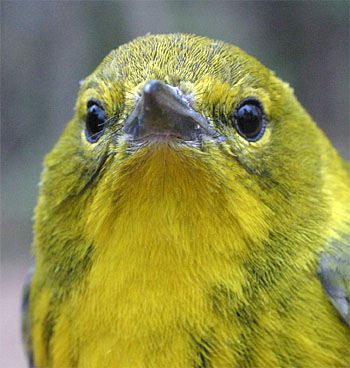 They take advantage of what is available, including suet and wild berries, and often join mixed flocks of sparrows, nuthatches, small woodpeckers, and--of course--American Goldfinches that may lead the warblers toward a variety of unanticipated food sources. One backyard birder we know attracts numerous Pine Warblers each winter by putting out an old pine cone filled with peanut butter-cornmeal mix, and the warblers are also known to take mealworms offered to bluebirds. They take advantage of what is available, including suet and wild berries, and often join mixed flocks of sparrows, nuthatches, small woodpeckers, and--of course--American Goldfinches that may lead the warblers toward a variety of unanticipated food sources. One backyard birder we know attracts numerous Pine Warblers each winter by putting out an old pine cone filled with peanut butter-cornmeal mix, and the warblers are also known to take mealworms offered to bluebirds.
If you're a Pine Warbler, it's probably good to hang with the goldfinches--not because you may resemble them in hue and markings but because those heavy finch beaks make short work of sunflower hulls at feeders and undoubtedly leave behind a little sunflower meat for you to nibble on. Such leftovers may be just the right energy source for any bright greenish-yellow warbler choosing to spend the winter at Hilton Pond Center.
All text & photos © Hilton Pond Center
Comments or questions about this week's installment?
Please send an E-mail message to INFO.
NOTE: Be sure to scroll down for an account of all birds banded or recaptured during the week, as well as some other interesting nature notes.
"This Week at Hilton Pond" is written & photographed
by Bill Hilton Jr., executive director of
Hilton Pond Center for Piedmont Natural History.
You may wish to consult our Index of all nature topics covered since February 2000. You can also use the on-line Search Engine at the bottom of this page.
For a free, non-fattening, on-line subscription to "This Week at Hilton Pond," just send us an E-mail with SUBSCRIBE in the Subject line. Please be sure to configure your spam filter to accept E-mails from hiltonpond.org.
|


 (Note that female goldfinches have browner wings that are nearer in color to those of the Pine Warbler.)
(Note that female goldfinches have browner wings that are nearer in color to those of the Pine Warbler.)


 They take advantage of what is available, including suet and wild berries, and often join mixed flocks of sparrows, nuthatches, small woodpeckers, and--of course--American Goldfinches that may lead the warblers toward a variety of unanticipated food sources. One backyard birder we know attracts numerous Pine Warblers each winter by putting out an old pine cone filled with peanut butter-cornmeal mix, and the warblers are also known to take mealworms offered to bluebirds.
They take advantage of what is available, including suet and wild berries, and often join mixed flocks of sparrows, nuthatches, small woodpeckers, and--of course--American Goldfinches that may lead the warblers toward a variety of unanticipated food sources. One backyard birder we know attracts numerous Pine Warblers each winter by putting out an old pine cone filled with peanut butter-cornmeal mix, and the warblers are also known to take mealworms offered to bluebirds.

 Oct 15 to Mar 15
Oct 15 to Mar 15
